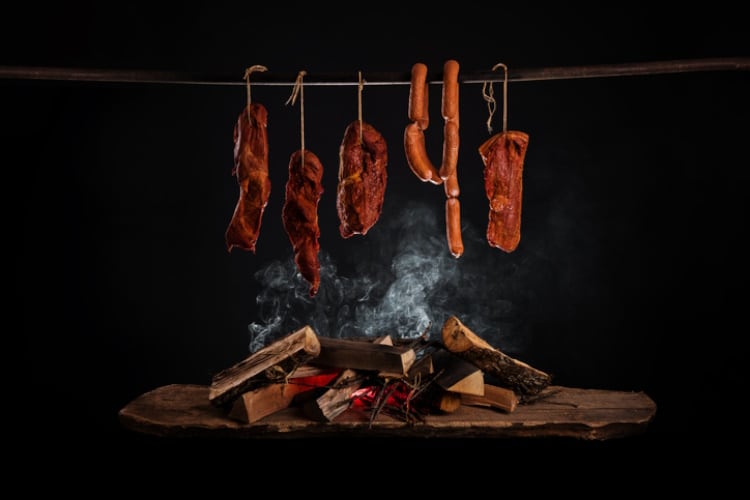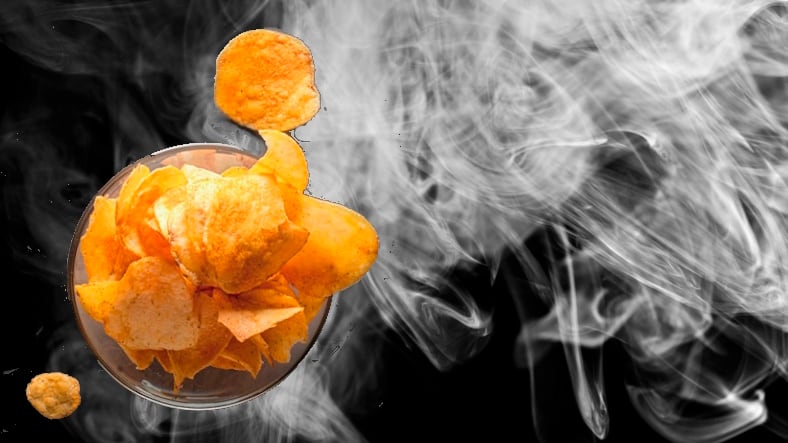In 2017, Marcia Mogelensky, Mintel’s director of Insight, told Bakery&Snacks that ‘smoked’ and ‘burnt’ were the flavor trends that were especially driving the snacks category. Consumers around the globe are enthralled by the subtle nuances of smoke, with terminology such as ‘fired’ and ‘charred’ giving producers their unique selling point (even filtering in the bakery segment, such as the much-loved Scottish delicacy: well fired rolls).
The flame-kissed tones have tendrils across the snacking category – from potato chips to popcorn and meat snacks. In fact, according to Irish ingredients specialist Kerry, one in every seven NPD launched globally is BBQ-focused, ‘barbecue’ is the third most popular snack flavor and ‘smoked’ is number one in the meat snacks category.
“The industry – responding to this growing demand – has innovated a multitude of methods to capture the essence of smoke flavor, extending beyond traditional smoking techniques to include a variety of smoke flavorings and smoked ingredients,” wrote Zeynep Ilkbahar, globa taste regulatory director, and Melissa Muldowney, global marketing director, Savoury Taste, in a recent KerryDigest.
“With barbecue and smoked tastes leading flavor profiles in snacks and meat respectively, the commercial food sector is at the forefront of adopting alternative approaches to encapsulate authentic smoky taste.”
Blowing smoke?

So the European Commission’s (EC) ruling to phase out eight smoke flavorings – termed Smoke Flavor Primary Products (SFPPs) – over the next two years is being greeted with dismay and even disdain. Several fans have branded it ‘madness’ on social media and Kerry has warned the decision could cause ‘major economic harm’ to the country’s food sector (Ireland has a long tradition of smoking salmon and bacon) and impact around €30bn ($32bn) worth of food products in the EU.
“Kerry is disappointed by the EC’s decision not to renew the existing authorisations of primary products which have been on the EU market for decades as a healthier and more sustainable alternative for smoking and imparting smoky taste to foods,” said the County Kerry-headquartered company’s Ilkbahar and Muldowney.
“The rich heritage and legacy of the Kerry Red Arrow portfolio represents a clean, safe and cost-effective solution to deliver smoke taste in food products. We will continue to supply our products into the EU until the expiry dates and to engage with the EC regarding securing reauthorisation of SFPPs.”
The basis for their derision?
While a November 2023 EC report cited potential cancer risks associated with the methods of extracting the smoky flavor, manufacturers argue there is no conclusive evidence linking the process to cancer.
A 2008 study by the European Food Safety Authority (EFSA) concluded the use of smoke flavorings is generally considered to be of less concern – to both personal health and the environment – than the use of traditional smoke.
In a 2023 Q&A, Wim Mennes, chair of EFSA’s working group on flavorings, conceded, “the chance that such harmful effects would occur as a result of consumption of foods flavored with smoke flavorings has not been investigated by EFSA,” adding it was “not possible” to define a safe level of consumption.
“In general, there may be an elevated risk of harmful effects when consuming genotoxic substances [and] the likelihood of these effects emerging depends on various factors, including an individual’s genetics and dietary habits,” he continued.
Genotoxicity is the ability of a chemical to damage the genetic material of cells. Changes or mutations to the genetic information within a cell may increase the risk of developing conditions like cancer and inherited diseases.
However, he claimed EFSA takes a conservative approach to its assessments, meaning “we consider worst-case scenarios to estimate hazards and risks.”
In question are eight SFPPs:
- proFagus Smoke R709, obtained by pyrolysis of beech and oak wood as main source materials
- Fumokomp Conc: produced by pyrolysis of beech and hornbeam woods
- proFagus Smoke R714: beech and oak wood
- Scansmoke SEF7525: obtained from a tar produced from a mixture of red oak, white oak, maple, beech and hickory
- Smoke Concentrate 809045: beech wood
- SmoKEz C‐10: maple, oak, hickory, ash, birch, beech and cherry woods
- SmokEz Enviro‐23: oak, maple, hickory, ash, birch, beech and cherry woods
- Zesti Smoke Code 10: hickory and oak woods.
Pyrolysis is a method to convert biomass to an intermediate liquid product. It involves burning wood, capturing the smoke in a condensing chamber and then purifying and decanting it to remove harmful components such as ash and tar, resulting in a liquid smoke that can be added to food.
Put that in your pipe and smoke it

Smoke flavorings are regulated separately from other flavorings in the EU as they consist of complex mixtures of substances, which give rise to different safety issues. As mentioned, the flavors are produced by condensing smoke, which contains a variety of complex chemical compounds, including polycyclic aromatic hydrocarbons (PAHs), which are known carcinogens.
By setting specific limits on certain harmful substances within smoke flavorings, the EU aims to minimize health risks for consumers, while also maintaining consistent and unform standards within the single market. Primarily governed by Regulation (EC) No 2065/2003, producers are required to undergo a detailed approval process and comply with specific labeling requirements.
The eight SFPPs had been assessed in 2012, deemed safe and authorised for use for 10 years. When that came up for renewal, a fresh review was undertaken by EFSA to evaluate their safety and permissible consumption level.
The results were very different, with the EFSA scientific panel concluding that six of the flavorings raised ‘a potential concern for genotoxicity’ while potential safety concerns could ‘not be ruled out’ for the remaining two.
proFagus Smoke R709 and proFagus Smoke R714 contain furan‐2(5H)‐one – surprisingly, also found in chocolate – known to cause damage to DNA when consumed.
Smoke Concentrate 809045, SmoKEz C‐10, SmokEz Enviro‐23 and Zesti Smoke Code 10 contain both furan‐2(5H)‐one and benzene‐1,2‐diol in quantities above the threshold of toxicological concern.
Scansmoke SEF7525 contains styrene and benzofuran, along with an unidentified part of the mixture, which led the panel to conclude the potential safety concern cannot be ruled out.
The scientists were also not entirely confident the method to create Fumokomp met the legal quality criterion that at least 80% of the volatile fraction is identified and quantified.
And in a cloud of smoke…

Following these findings, in April this year, the 27 Member States agreed to a complete ban of all eight.
“The Member States have endorsed a proposal from the Commission to not renew the authorisation of eight smoke flavorings for food,” said the European Commission in a statement.
“After a phase-out period, these flavorings will no longer be permitted for use in the EU.
“The relevant decisions are based on scientific assessments by the European Food Safety Authority that concluded that for all eight smoke flavorings assessed, genotoxicity concerns are either confirmed or can’t be ruled out. EFSA’s opinion is based on an updated methodology, assessing new data submitted by the applicants. It concerns the specific flavorings that can be added to food, and not the food itself.
“Following extensive discussions with Member States and stakeholders, the Regulation sets out different phase-out periods to give time for producers and operators to adapt to the new rules.
“When used to replace traditional smoking (eg. hams, fish, cheeses), the phase-out period is five years.
“For uses where the smoke flavoring is added for extra flavour (eg. soups, crisps, sauces), the phase-out period will be two years.
“The Regulation will be formally adopted by the Commission in the coming weeks, to enter into force later this spring.”
The European Snacks Association (ESA) – Europe’s only trade organization dedicated to advancing the savory snacks industry – told Bakery&Snacks it is behind the EC decision.
"ESA fully supports the Commission’s commitment to ensuring the safety of Smoke Flavorings Primary Products (SFPPs) while minimizing disruptions in the market," an ESA spokesperson told this site.
"The main priority of ESA’s members is to guarantee and maintain the highest levels of food safety. The European savory snacks industry is complying with the European legislation and hence will act in accordance with the decision of non-renewal of the current authorisations."
Smokin’

Smoking foods is an ancient practice that dates back thousands of years, with its history intertwined with the development of human civilization and culinary traditions. It’s still used to preserve foods like fish, meat and cheese, while also adding a unique flavor profile and sometimes changing texture (breaking down collagen, forming a bark, dehydrating, helping to retain moisture).
The global popularity of barbecuing – aka cookout, braai, parrillada, barbie, barbacoa, tandoor, yakiniku and lūʻau, among others – have kept the tradition alive and both chefs and home cooks love to experiment with woods, methods and flavors.
The advancement of extraction and flavoring technologies in the late 20th century boosted its uptake, allowing for the creation of natural flavorings that could replicate the taste of traditional smoking methods without the associated health risks. The allure of the pit-roasted taste has seen a remarkable surge across the world and industry has responded, developing a range of methods to capture its essence.
Acquired in 2015 in a $735m deal for Red Arrow Products, Island Oasis and Biothera Inc’s Wellmune business, Kerry has perfected the sensory lexicon to enhance its Red Arrow range that imparts a consistent smoked taste, color and texture for a variety of applications, from snack seasonings to hickory-smoked sauce or charcoal-grilled meat.
Its Condensed Smoke portfolio is generated from wood that is a byproduct of the lumber industry then processed to remove tar and ash, which is upcycled: the tar as a fuel source to dry the sawdust and the ash as asphalt for road construction.
According to the ingredients specialist, this process reduces emissions by 80% and cleaning water and chemical usage by 70% versus conventional smoking process. It also reduces 30% in energy consumption compared to stanard wood chip smoking.
While sustainable, Kerry claims it’s impossible to recreate the authentic taste of smoke using natural flavoring raw materials. So the next best alternative is to use a smoked ingredient, like smoked sugar, onion powder, garlic powder or maltodextrin. Grill flavors – made by heating and cooling oil through a proprietary process – is another way to create the authentic taste of the fireside.
However, launched in March is Sensient’s SmokeLess Smoke range – a clean label range that mimics the ‘unique signatures’ of conventional smoky flavor notes, including:
- Smoke type: strong ashy with a balanced fruity and woody undertone
- Hickory type: very earthy and woody
- Oak type: sweet woody style with mild burnt and nutty notes
- Mesquite type: sweet barbecue-style flavor with savory umami notes and a bacon undertone
The range is vegan, non-GMO, halal and kosher and can be used to flavor snacks, meat, fish, cheese, dairy and beverages.
“Our team of flavorists from around the world developed smoke flavor profiles – without actual smoke – by selecting and combining natural raw materials that are safe and compatible with consumers’ expectations,” said the flavor house’s global marketing manager Mitin Rathod, global marketing manager for Sensient Flavors & Extract Europe.
“What’s more, they have done this while identifying our customers’ needs and their applications and processes, validating our aromatic solutions within our customers’ finished products.”



